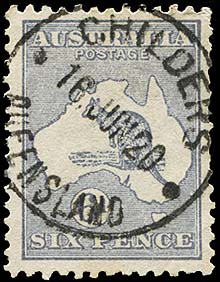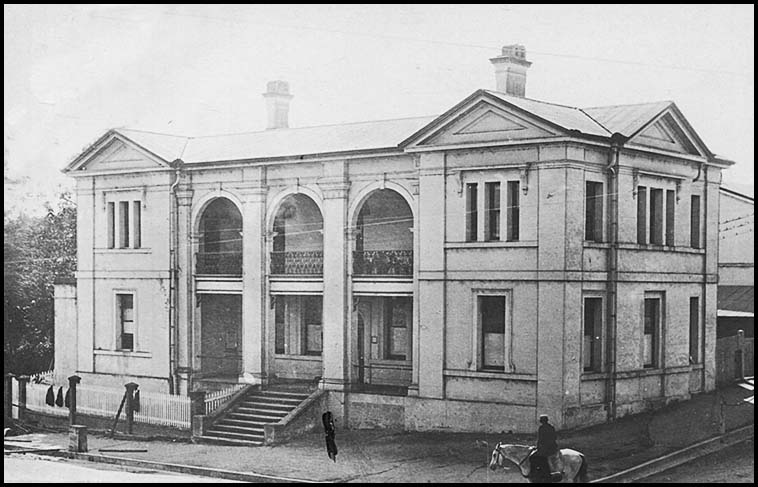Telegraph Offices from Brisbane and Roma north to St. Lawrence.
- Australia 1901-1988
- New South Wales
- Queensland
- South Australia
- Tasmania
- Victoria
- Western Australia
- International
- Special aspects
The following Telegraph Offices are included in this page:
|
Due west from Gympie and Black Snake. |
|
A circular T.O. date stamp with QLD AUST at the base was issued to the Telegraph Office:
|
 11 December 1940. |
|
|
No special date stamp for use with telegraph work appears to have been issued for Bundaberg. One slogan postmark advertising Telegrams is recorded as being used at Bundaberg. |
|
|
From the Brisbane Courier of Friday 17 May 1889:
|
|
The Telegraph Office was opened at Caboolture on 26 July 1869 as an intermediate station between Gympie and Brisbane. It would therefore served a dual purpose - an a station to serve the local community and also to be a repeater station. The Moreton Mail of 6 August 1887 reported a development which was likely to occur when the railway line, then under construction to Caboolture, had been completed: "A deputation of residents of Caboolture, consisting of Messrs. W. H. Payne, M. Zillman, J. Farry and M. Battersby, was introduced to the Postmaster-General on Wednesday (3rd) for the purpose of requesting that the business at the Post and Telegraph office at Caboolture should not be removed from the present building to the railway station. The deputation nad been the outcome of a public meeting, and it was urged that great inconvenience would be occasioned by the proposed change. Some of the arguments used were that children would run the risk of accidents in going to the railway station for letters and the inconvenient distance of the station from the present Post Office. The Postmaster-General promised that he would consider the matter and, until the railway had been opened to Caboolture, no action would be taken in making the change complained of". |
|
| P | |
|
|
|
The Telegraph Office was opened on 16 October 1867. The Government Gazette of 7 December 1867 announced that Mr. J. C. Bauer was to be Station Master at the Clermont Electric Telegraph Station and Mr. Stephen O'Brien was to be line repairer at the same station. The Gazette of 1 May 1869 called for tenders to construct a Telegraph Office at Clermont. Some delays were clearly encounted because the Brisbane Courier of 10 January 1870 informed its readers that "A site is reserved in Drummond Street for Post and Telegraph offices at Clermont". |
|
|
|
Date stamps. No special date stamp was issued to the Clermont Telegraph Office for use with telegraphic matters. A hole puncture was used to puncture stamps and used mainly for high value stamps used on telegraph transmission forms as well as other telegraph-related purposes. |
|
 |
Clermont 9 May 1917. Stamps have been punctured with large holes. Status Auctions February 2024, Lot 1045.
|
|
In 1879, Frank Lee Morris was the Railway and Telegraph Station Master at Dingo. |
 Dingo date stamp of 12 July 1877. Clear date stamp on and excellent cover sent to London but readdressed to Staplehurst, Kent. Lovely three colour franking with 1d orange-vermillion, 2d blue and 6d green. Millennium November 2023, Lot 494. |
|
Telegraph Office opened on 4 January 1865. It was the first station to be opened during the construction of the line from Dalby to Taroom. The Office closed on 31 August 1880. However, on 29 April 1884, tenders were called for the erection of a new Post and Telegraph Office at Durah. |
||
| A rare RO3: ELECTRIC TELEGRAPH OFFICE oval date stamp of Durah.
|
 No date. |
|
|
The Telegraph Office opened on 3 May 1877. In 1880, 2,351 messages were sent from the Telegraph Office at the Railway Station including 420 OHMS messages. The staff of the Telegraph section consisted of one operator and one messenger. The Railway Station including the Telegraph Office was totally destroyed by fire on 26 March 1892: "about 9 o'clock on Saturday night, the gas engine at the station exploded and the place was instantly wrapped in flames. So rapidly did the fire appear to have spread that the officials were only able to save a few ticket cards and the cash in the safe. There were no means of extinguishing the fire at hand". Unfortunate timing because in February, tenders had been called for the construction of a new Post and Telegraph Office, the tenders had been opened on 2 March and on 11 March the tender submitted by "G. Holmes, amount £593 13s. 9d., time three months, has been accepted, the amount mentioned including fencing". The Western Champion of 17 January 1893 reported that "Information was received that Mr. B. Powell, manager of the Post and Telegraph office at Emerald was seized with a severe attack of dysentery on Thursday evening and died on Saturday". The Government Gazette of 18 March 1893 announced "John Robert Kelly to be manager of the Telegraph Office and Postmaster at Emerald in the room of Powell, deceased". On 11 January 1912, the Minister for Home Affairs (Mr. O'Malley) agreed to the erection of a new Post and Telegraph office at Emerald being carried out under the supervision of the Queensland Works Department. |
||
 Emerald Post & Telegraph Office about 1920. |
|
A Tender was let in September to J. P. Mittlehauser for the construction of a Post and Telegraph Office at Gin Gin to cost £1,017 15s and to be completed in eight months. |
|
| No special date stamp was issued to Gin Gin for use with telegraphs. Instead the usual postal date stamp was used. |  25 June 1913. |
| No special date stamp for use with telegraph work appears to have been issued at Gympie.
A SEND A TELEGRAM slogan cancellation was used on Only recorded example. Die 2: A over GR. |
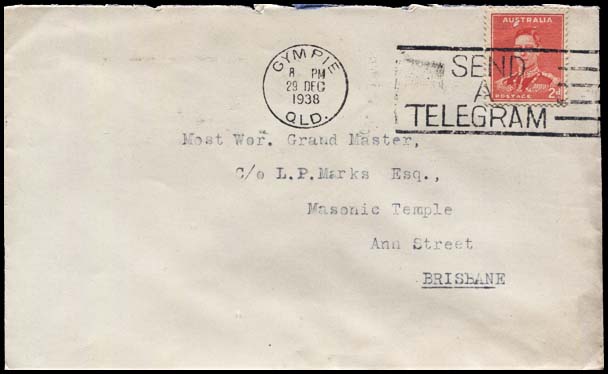 29 December 1938. |
|
Situated just below Yeppoon, the Telegraph Office was opened ?? In the 1880s, the Postal Department agreed to a regular mail service between Hidden Valley and Doongmabulla via via Mount Wyatt, The Bridge, Glen Lee, Bowman's, Mount Douglas and Bulli Creek, by horse, once a week, for one, two, or three years. A T.O. date stamp was issued to Hidden Valley. |
|
Used in black: 24 November 1945 to 24 February 1959. |
 24 March 1954. |
 24 February 1959. |
|
At some time during the early 1960s, the date stamp for Hidden Valley had the prefix TO removed. Rated: Scarce. |
|
|
The Telegraph opened on 15 May 1878. It subsequently closed on 1 October 1887 and then re-opened on 13 August 1888. In April 1899, tenders were called for the construction of "a new telephone line from Jimbour post and telegraph office to Bell, a distance of 12 miles 10 chains, more or less". |
|
|
A Telegraph Office was opened at the Pilot Station at Keppel Bay on 11 September 1867. From the reports sent in regularly, it appears the main task was to monitor the movements of smaller raft such as schooners of various types and barques. In February 1874 it was announced that the pilot station was to have an addition to house the Telegraph Office. The Rockhampton Bulletin of 30 January 1877 noted in a review of local issues that "The telegraph lines continue in working order, but a rather curious phenomenon came to our knowledge yesterday. It was found that telegrams could be received from Keppel Bay, but could not be forwarded thither as the line was working only one way. This freak of the wire is known to electricians. We believe the line to the Bay was again in good working order last night". Further improvements were made to the Telegraph Office in January 1878. A new Post &Telegraph was called for in 1886. The Telegraph Office closed in 1921. |
|
|
Kilcoy is north-west of Caboolture and inland from Woodford. A tender for the construction of a new Post and Telegraph Office was let in March 1913 to E. Tofield for £678. In June 1909, with the advent of telephone services, it was planned to supersede the existing contract office at Kilcoy by an official Post and Telegraph Office as soon as funds were available. |
 Kilcoy Post & Telegraph Office about 1914. |
No special date stamp for use with telegraph work appears to have been issued at Mackay. An oval date stamp (RO3 - PO) was however issued to the Post Office. Perhaps that date stamp was used for telegram work - a possibility suggested by the block of 6 at the right. The block paid 1/- which was a common charge for sending a telegram to another station in Queensland except the GPO at Brisbane. The format of this date stamp is similar to that used at Wolloongabba. |
 13 August 1907. |
| A SEND A TELEGRAM slogan cancellation was used between 7 April 1938 and 24 November 1938. |
 24 November 1938. |
|
In the Queensland Times of 20 May 1865: "The telegraph station master in Ipswich, Mr. Burkitt, informs us that the new Northern stations Marlborough and St. Lawrence (Broad Sound) are now open for receipt and despatch of messages". That news could be two months old. |
|
The usual postal date stamp was used at Marlborough.
|
 20 May 1913. |
|
The Brisbane Courier of 5 May 1865 announced that tenders had been called for the construction of an impressive Post and Telegraph Office and went on to describe the design. Maryborough was a designated repairing station. In 1880, 25,111 messages were sent including 1,947 OHMS messages. The telegraph staff consisted of an Electric Telegraph Station Master, 3 operators, 1 line repairer, 3 clerical assistants and 2 messengers. |
||
 Maryborough P&T office about 1865 - with the new Telegraph pole. Source: Australian National Archives J2879 QTH191. |
 Maryborough P&T office (circa 1910). The Post Office was on the left and the Telegraph Office on the right. |
|
An advertisement appeared in the Brisbane Courier of 2 May 1872 for a clearance sale of the stock held by a Mr. Cochran. The first item listed was "a large Turret Clock, 5 foot dial, gilt figures, made to order for the Post and Telegraph office, Maryborough, at cost of £40. This Clock is in perfect going order, and is suited for a public building". No other aspect of this advertisement can be found. |
||
Date stamps: No special date stamp for use with telegraphic work is known for Maryborough. The usual postal date stamp available at the time was used on telegrams. |
||
A SEND A TELEGRAM slogan cancellation was used between 14 April 1939 and 20 November 1939. Die 2: A over EG. |
 |
|
Mount Chalmers is north-east of Rockhampton. After some gold mining between 1869 and about 1900, copper mining began about 1899 through to about 1914. The town was served by a Post & Telegraph Office and a Railway Station was opened in the early 1900s.
|
|
|
Murgon is west of Gympie and north of Kingaroy. |
 |
|
Nanango was the fourth oldest settlement of a town in Queensland - in July 1848. This establishment was the opening of a hotel by Jacob Goode - and understandably this was called Goode's Inn. On 5 January 1852, the Goode's Inn Post Office was opened. It was renamed Burnett on 1855 and then Nanago on 1 July 1859. Gold was discovered near Nanago in 1867 but only a limited amount was found. The Railway was extended to Nanango in 1911. |
|
During the Colonial period, an oval ELECTRIC TELEGRAPH OFFICE date stamp was issued to Nanango at an unknown date. |
 Nanango Electric Telegraph Office. Size: 27 × 42 mm (e = 0.77). Used on QC-DO-8. |
The usual postal date stamp was used fir telegraph work. The date stamp shown here was used on the top half of a Reply Paid form (QI-DR-1) used for delivery of the origibal message sent to Nanango from Brisbane. |
 19 July 1911. |
| Nebo.
The Gazette of 1 May 1869 called for tenders to construct a Telegraph Office at Nebo. The Office opened later in 1869. In September 1869, Nebo was the receiving station for an experiment conducted by Mr. Kraegen, Post and Telegraph Master at Deniliquin, NSW to send an uninterrupted message along the wires for 2,700 miles from Adelaide. |
|
In the House on 25 May 1864 Mr. Herbert stated that the Government would have no objection to placing in the Estimates an amount for the extension of the telegraph line from Rockhampton to the gold fields on Peak Downs. |
|
The Telegraph Office was opened on 4 January 1865. The Post Office had been established on 1 April 1858 by New South Wales in the Moreton Bay District before being transferred to Queensland on 1 December 1859. Tenders were called in February based on revised plans for the Rockhampton Telegraph and Post Office due 25 March 1865. In 1880, 36,351 messages were sent including 2,835 OHMS messages. The telegraph staff consisted of an Electric Telegraph Station Master, 9 operators, 1 line repairer, 4 clerical assistants and 3 messengers. |
|
| The Bulletin of 5 June 1866 reported "The new clock for the front of the tower dividing the Electric Telegraph Office from the Post Office, arrived by the Leichardt from Brisbane. The dial plate was fixed in the circular hole prepared for it yesterday afternoon. The diameter of the dial measures three feet six inches and it is, by six inches, larger than any clock in the colony. The numbers and portions of the hands are gilt over a black ground; the clock is the manufacture of Mr. Cochran of Brisbane. Today it will be in going order, and will be set to the Rockhampton time".
On 9 April 1883 a new Telegraph office was opened. See also http://www.cqhistory.com/wiki/pmwiki.php/Institutions/ |
|
 The "new" Rockhampton Post & Telegraph Office. |
|
|
|
The Evening News of 16 March 1874 reported the following which might have emanated from the Rockhampton Telegraph Office: "An amusing telegraphic blunder was perpetrated by the Rockhampton Bulletin of the 7th instant. Our readers will recollect that a message was, a few days ago, received from Melbourne stating that in the course of the hearing of a cause in which Mr. Treen was the plaintiff, it was elicited that £13,000 had been expended in the attempt to establish a daily paper called The Express and a weekly paper piratically entitled The Melbourne Town and Country. Our Northern contemporary thus renders the message: "During a trial to-day it was stated that it took £13,000 to start an express train for the town and country papers". On 24 May 1913, a Coastal Radio Station was opened at Rockhampton. |
|
Date stamps for Rockhampton. There are five formats for date stamps used at Rockhampton. |
||||
Electric Telegraph Office Oval date stamp (BO3-ETO). This format is unique in that it has the crown outside of the ellipses.
|
 30 January 19?? |
|||
 2 January 1902. Status Auctions, September 1921. |
 20 December 1902. |
|||
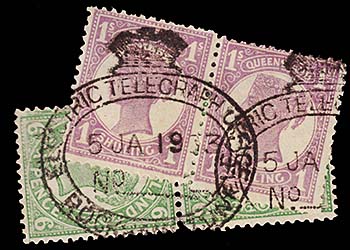 5 January 1903. Status Auctions, January (Lot 1630) to October 2011. |
 12 January 1903. Status Auctions October 2021 Lot 3074. |
|||
|
|
|
||
|
 14 December 1931. |
|||
|
 7 February 1967.
|
|
|
 13 March 1978. Used on AA-DO-13D. |
|
|
The Telegraph Office opened on 10 April 1872 about a week after connection was made to Brisbane. It was an officially designated a repairing station. In 1874, a question in the Legislative Assembly pointed out the inadequacy of the £450 then budgeted for a new P&T building. The Queenslander of 5 February 1876 described the situation as follows:
Construction of a new facility commenced in 1877. The Northern Daily Argus of 13 September expressed satisfaction with the progress on behalf of residents:
In January 1878, the new building was completed - at a cost of £700. In 1880, 2,456 messages were sent including 250 OHMS messages. The staff of the Telegraph section consisted of one Electric Telegraph Station Master and one line repairer. On 12 April 1893, the Brisbane Courier described Springsure, inter alia, "Springsure is in the Bauhinia division, Leichhardt electorate, and has a population of some 600 persons ... In the town proper are three hotels, three stores and several nondescript establishments. The public buildings are the police quarters and court-house, Post and Telegraph office and State school - the latter with an average attendance of 70 scholars". |
|
| St. Lawrence.
The area was originally referred to as Broad Sound - so named by Capt. James Cook on the basis of its size (50 km long and 20 km wide). As a Port was established to export cattle around St Lawrence Creek, the place became known by that name. The Telegraph Office opened on 10 March 1865 with the Post Office changing name from Waverley. In February 1874, a severe storm hit the region. The Post and Telegraph line was blown away with Mr. Ahern escaping with only the instruments. The Court House, Custom House, two hotels and miles of telegraph posts were all blown away. Sheets of galvanised iron were blown up to three miles away. The aftermath was described as "St. Lawrence presents a wreck which beggars description". A new Telegraph Office was completed in January 1878. |
|
A steel oval date stamp (SO3-ETO) was available
A very rare page of the archival strikes for St. Lawrence is shown elsewhere. |
 Possibly used in January 1898. |
|
In the House on 25 May 1864 Mr. Herbert stated that the Government would have no objection to placing in the Estimates an amount for the extension of the telegraph line to Taroom. The Telegraph Office opened on 29 December 1865. The Maryborough Chronicle of 26 August 1869 references the D.D. Gazette which has:
The case was a paternity and child support issue. Prior to the heaing described above, Mr. Barry "had also been summoned to attend and give evidence as a witness but that nothing was either paid or tendered him for his expenses and that, in consequence, he refused to attend. Taroom is 240 miles from Toowoomba and evidence was given to show that Barry could not absent himself from his station without first obtaining leave from Brisbane as, if he did, all telegraphic communication with Taroom would be interrupted as there was no-one to take his place nearer than Hawkwood. It appeared that the rule nisi was granted on the supposition that the Bench had issued a warrant to compel Barry to attend and give evidence as a witness only. Their Honors held that the role should be discharged" (The Queenslander 29 May 1869, p. 7). |
|
|
Thompson Point (as it is now known without the possessive s) is located on the coast about 26 km ESE of Rockhampton. It is situated on the banks of the Fitzroy River. Between 1899 and 1929, it was a town and port called BroadmountHerbert was the official name for Broadmount until 1923 although the local name had been Broadmount since the 1880s. . To ensure the decision to establish Broadmount as the port to service Rockhampton instead of nearby Port Alma, the Queensland Government considered the decision fully from about 1862 to about 1899 when the wharf construction was completed that taking only three years). The port was established because it was understood the larger ships could not traverse the Fitzroy River to Rockhampton but could use Broadmount if dredging was undertaken. The dredging did not happen. For full details read the story elsewhere. A Provisional School had operated there for about five years from 1901 and a Post Office was open at Thompson Point from about July 1905 to July 1908. In the 2021 Census, Thompson Point had "no people or a very low population". |
|
| A Type BO3 - Electric Telegraph Oval brass date stamp was issued to the Office. | |
Used on a postcard sent to Glasgow, Scotland and showing a picture of Point Danger. The message has been written over the photograph on the front (harder for prying eyes to read). The postcard was franked with a ½d green and 1d orange postage stamps to pay the international postcard rate. |
 |
|
|
|
The Morning Bulletin of 11 April 1889 reported that
In January 1914, a proposal was put before the Postmaster-General for a telephone service - there already being a telegraph office there. It was declined on the basis that the cost would not be able to be recovered. |
|
The usual postal date stamp was used at Tungamull.
|
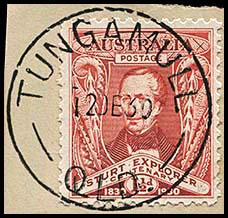 12 December 1930. |
| Woody Island.
This Woody Island is in Harvey Bay east of Maryborough. A much smaller island of the same name is off Port Douglas - a long way to the north. The Telegraph Office was opened on 9 March 1869. A narrative of the laying of the cable to Woody Island is provided elsewhere. |
 The pier at Woody Point on Woody Island. Postcard used in 1912. |









